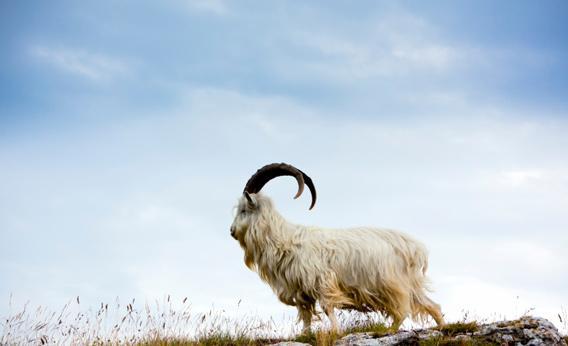Winter is upon us, which means that cashmere sweaters—a staple of holiday gift-giving and cold-weather fashion—have returned to store shelves. Those planning to purchase a garment boasting the label “100 percent cashmere” can expect a hefty price tag; at Banana Republic, one cardigan is priced at $198; elsewhere, you can find cashmere sweaters for upward of $500. Why is cashmere so much more expensive than other kinds of wool?
Its costly production process and scarcity. Cashmere comes from the soft undercoat of goats bred to produce the wool. It takes more than two goats to make a single two-ply sweater. The fibers of the warming undercoat must be separated from a coarser protective top coat during the spring molting season, a labor-intensive process that typically involves combing and sorting the hair by hand. These factors contribute to the relatively low global production rate of cashmere—approximately 6,500 metric tons of pure cashmere annually, as opposed to 2 million metric tons of sheep’s wool.*
The name cashmere comes from an old spelling of Kashmir, the region where its production and trade originated, possibly as early as the Mongolian empire in the 13th century. According to historian Michelle Maskiell, author of “Consuming Kashmir: Shawls and Empires, 1500-2000,” from the 1500s to as late as the early 1900s, Iranian and Indian emperors used Kashmiri shawls in political and religious settings; in the Mughal Indian courts, for example, the acceptance of a shawl from a political figure established a hierarchy between the giver and the receiver. In the late 18th century, Scottish textile manufacturer Joseph Dawson discovered shawls made from cashmere in India and began to import the material to his factory in Scotland. Dawson sold shawls to upper-class British women who prized the fabric for its softness and warmth. (High-quality cashmere can be up to eight times warmer than sheep’s wool despite its light weight.)
But not all cashmere is equally luxe: The texture, color, and length of the fibers all affect manufacturing and pricing. Naturally, whiter cashmere fibers require less dye, diminishing the damage that coloring causes to its natural softness. Quality also depends on the region in which the wool is collected. In Inner Mongolia, for instance, the winters are harsh and the goats have a more meager diet, which produces the finer hair seen in the highest quality garments. Still, even the best raw material can be compromised by a sub-par finishing process. The fineness of a cashmere item comes down to that process, as the spinning and weaving of the fabric affects the look, feel, and touch of the final product.
China is the largest supplier of the raw material needed to make cashmere wool, but Europe has mastered cashmere manufacturing methods, and has cornered the market on premium quality (and costlier) products.
Luxury Explainer thanks Nick Hahn, founder of Hahn International, LTD and Karl Spilhaus, president of the Cashmere and Camel Hair Manufacturers Institute.
Correction, Dec. 28, 2012: This article originally misstated the annual production rate of cashmere and sheep’s wool. (Return to the corrected sentence.)
